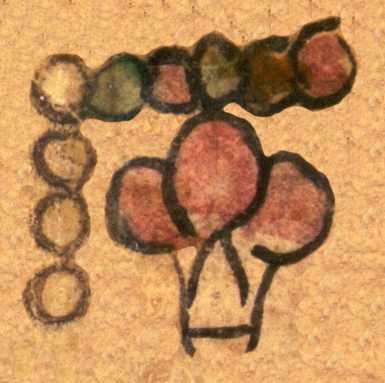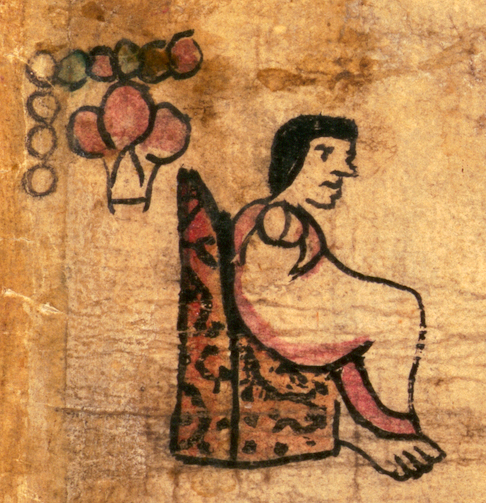Chiucnahui Xochitl (CQ)
This compound glyph-notation stands for the personal name Nine Flower or 9-Flower (Chiucnahui Xochitl or Chiucnauhxochitl), which is a date from the calendar. It consists of a right-angled group of ones (small circles), four up the left side of the flower and five across the top. The five circles along the top of the flower are painted--red, brown, and turquoise blue (one almost looks green, having some brown smeared over it) in no conceivable pattern. What is more, the four on the left are left unpainted, natural. The flower has three visible red petals and a white or unpainted base.
Stephanie Wood
Perhaps the uncolored circles were going to be painted, but were left unfinished because of an interruption or distraction. Otherwise, there may be an undiscovered, intentional motive for leaving some circles natural. The difference in coloring the circles does make the grouping of four and the grouping of five standout. As the context image indicates, 9-Flower is the name of an elite male, given that he is wearing a man's cape (tilmatli) and he sits on a jaguar-covered icpalli (Indigenous throne or seat of authority).
Stephanie Wood
covers ruling men and women of Tecamachalco through 1593
Randall Rodríguez
flower, flor, nine, nueve, numbers, números, names, nombres, dates, fechas, calendarios, nombres de hombres

chiucnahui, nine, https:nahuatl.wired-humanities.org/content/chiucnahui
xochi(tl), flower, https:nahuatl.wired-humanities.org/content/xochitl
tilma(tli), cape, https:nahuatl.wired-humanities.org/content/tilmatli
icpal(li), seat of authority, https:nahuatl.wired-humanities.org/content/icpalli
Nueve Flor, 9-Flor
The Codex Quetzalecatzin, aka Mapa de Ecatepec-Huitziltepec, Codex Ehecatepec-Huitziltepec, or Charles Ratton Codex. Library of Congress. https://www.loc.gov/item/2017590521/
The Library of Congress, current custodian of this pictorial Mexican manuscript, hosts a digital version online. It is not copyright protected.





